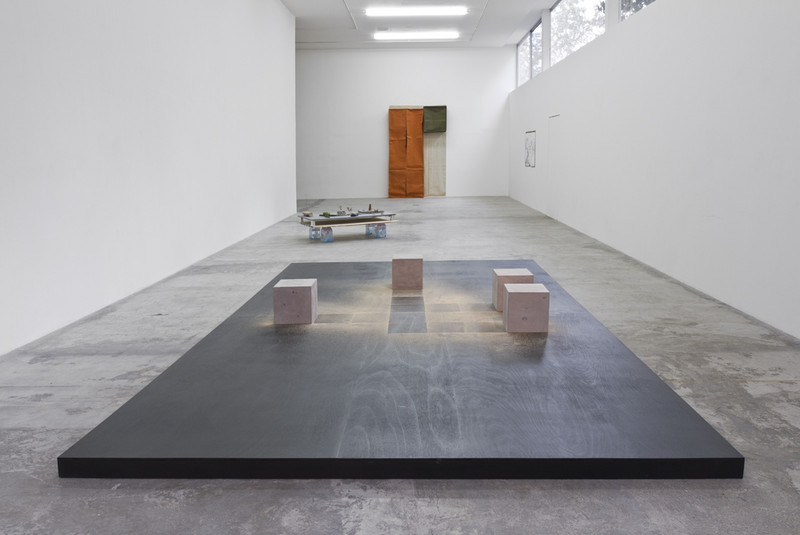The Forgotten Instinct
19 Jan - 02 Mar 2013
THE FORGOTTEN INSTINCT
William Anastasi, Guillaume Leblon, Hans Schabus, Francisco Tropa, Franz Erhard Walther
Gallery Jocelyn Wolff exhibits at gallery Labor, Mexico City
19 January - 2 March 2013
Francisco Ramírez #5 Col. Daniel garza Del. Miguel Hidalgo 11830, México D.F.
« La fiction est mise en forme,
élaboration objective,
de la vérité du sujet,
qui n’existe pas en réalité. »
“Fiction is formatting,
objective elaboration,
of the truth of the subject,
which does not exist in reality.”
Roger Lewinter, le vide au milieu (The Void in the Middle) 1987.
A Paris-Mexico City exchange
As so often, at the origin of this project, an encounter: when I began discussing with Pamela Echeverria, I immediately felt that we not only shared the same passion for art but also the same desire to run a gallery as a project space, a laboratory, a place for exchanging, and this, while taking constant care to nourish our idealism each day. We decided to exchange our respective spaces: the time for each an exhibition. Pamela chose to show Pablo Vargas Lugo in Paris. For Mexico, I preferred to think the exhibition terms of a synthesis of the esthetic preoccupations that irrigate the gallery’s program, especially as research has constantly intensified over years of the gallery’s existence.
L’instinct oublié /The Forgotten Instinct
The origin of this project lies in a meditation towards a key postulate in Spinoza thought: the body exceeds the knowledge we have of it; thought exceeds the consciousness we have of it. The notion of art as action (Franz Erhard Walther, Tropa) or the relationship to space and time in the work of Anastasi make it possible to approach this space and this movement and to extend a reflection about the art studio as a moral space (Schabus, Leblon).
About quantity
It appears to me that, these days, a new existentialism feeds upon the consciousness of the contemporary proliferation of images and demands to reconsider substantial artistic positions.
“What characterizes the times is above all the absence of landmarks: memories are pieces of life ripped from the void. No tie down. Nothing anchors them, nothing fastens them. Almost nothing ratifies them. (G. Perec, “W, or the Memory of Childhood”).
William Anastasi, Guillaume Leblon, Hans Schabus, Francisco Tropa, Franz Erhard Walther
Gallery Jocelyn Wolff exhibits at gallery Labor, Mexico City
19 January - 2 March 2013
Francisco Ramírez #5 Col. Daniel garza Del. Miguel Hidalgo 11830, México D.F.
« La fiction est mise en forme,
élaboration objective,
de la vérité du sujet,
qui n’existe pas en réalité. »
“Fiction is formatting,
objective elaboration,
of the truth of the subject,
which does not exist in reality.”
Roger Lewinter, le vide au milieu (The Void in the Middle) 1987.
A Paris-Mexico City exchange
As so often, at the origin of this project, an encounter: when I began discussing with Pamela Echeverria, I immediately felt that we not only shared the same passion for art but also the same desire to run a gallery as a project space, a laboratory, a place for exchanging, and this, while taking constant care to nourish our idealism each day. We decided to exchange our respective spaces: the time for each an exhibition. Pamela chose to show Pablo Vargas Lugo in Paris. For Mexico, I preferred to think the exhibition terms of a synthesis of the esthetic preoccupations that irrigate the gallery’s program, especially as research has constantly intensified over years of the gallery’s existence.
L’instinct oublié /The Forgotten Instinct
The origin of this project lies in a meditation towards a key postulate in Spinoza thought: the body exceeds the knowledge we have of it; thought exceeds the consciousness we have of it. The notion of art as action (Franz Erhard Walther, Tropa) or the relationship to space and time in the work of Anastasi make it possible to approach this space and this movement and to extend a reflection about the art studio as a moral space (Schabus, Leblon).
About quantity
It appears to me that, these days, a new existentialism feeds upon the consciousness of the contemporary proliferation of images and demands to reconsider substantial artistic positions.
“What characterizes the times is above all the absence of landmarks: memories are pieces of life ripped from the void. No tie down. Nothing anchors them, nothing fastens them. Almost nothing ratifies them. (G. Perec, “W, or the Memory of Childhood”).

